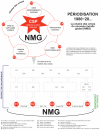"Globalized public health." A transdisciplinary comprehensive framework for analyzing contemporary globalization's influences on the field of public health
- PMID: 22312210
- PMCID: PMC3270903
- DOI: 10.2147/RMHP.S6134
"Globalized public health." A transdisciplinary comprehensive framework for analyzing contemporary globalization's influences on the field of public health
Abstract
The current phase of globalization represents a "double-edged sword" challenge facing public health practitioners and health policy makers. The first "edge" throws light on two constructs in the field of public health: global health (formerly international health) and globalized public health. The second "edge" is that of global governance, and raises the question, "how can we construct public health regulations that adequately respond to both global and local complexities related to the two constructs mentioned earlier (global health and globalized public health)?" The two constructs call for the development of norms that will assure sustained population-wide health improvement and these two constructs have their own conceptual tools and theoretical models that permit a better understanding of them. In this paper, we introduce the "globalized public health" construct and we present an interactive comprehensive framework for critically analyzing contemporary globalization's influences on the field of public health. "Globalized public health", simultaneously a theoretical model and a conceptual framework, concerns the transformation of the field of public health in the sociohistorical context of globalization. The model is the fruit of an original theoretical research study conducted from 2005 to 2008 ("contextualized research," Gibbons' Mode II of knowledge production), founded on a QUAL-quant sequential mixed-method design. This research also reflects our political and ideological position, fuelled with aspirations of social democracy and cosmopolitical values. It is profoundly anchored in the pragmatic approach to globalization, looking to "reconcile" the market and equity. The model offers several features to users: (1) it is transdisciplinary; (2) it is interactive (CD-ROM); (3) it is nonlinear (nonlinear interrelations between the contextual globalization and the field of public health); (4) it is synchronic/diachronic (a double-crossed perspective permits analysis of global social change, the emergence of global agency and the transmutation of the field of public health, in the full complexity of their nonlinear interaction); (5) it offers five characteristics as an auto-eco-organized system of social interactions, or dynamic, nonlinear sociohistorical system. The model features a visual interface (five interrelated figures), a structure of 30 "integrator concepts" that integrates 114 other element-parts via 1,300 hypertext links. The model is both a knowledge translation tool and an interactive heuristic guide designed for practitioners and researchers in public health/community health/population health, as well as for decision-makers at all levels.
Keywords: conceptual framework; contemporary globalization; diachronicity; knowledge translation tool; nonlinearity; public health; sociohistorical system; synchronicity; theoretical model; theory; transdisciplinarity.
Figures




References
-
- Beaglehole R, Bonita R. Public health at the crossroads Achievements and prospects. 2eéd. Cambridge, Royaume-Uni: Cambridge University Press; 2004.
-
- Roy M Collectif de conférenciers. Actes du colloque «Les enjeux éthiques en santé publique». Montréal, Québec: ASPQ Éditions; 1999. Les enjeux en santé publique exigent une éthique pour la complexité; p. 7.
-
- Chiffoleau S. Santé et inégalités Nord-Sud: la quête d’un bien public équitablement mondial. In: Les biens publics mondiaux. Un mythe légitimateur pour l’action collective? Paris, France: L’Harmattan; 2002. pp. 245–268.
-
- Contandriopoulos AP. À la recherche d’une troisième voie: les systèmes de santé du XXesiècle. In: Pomey M-P, Poullier JP, Lejeune B, editors. Santé publique. Paris, France: Masson; 2000. pp. 637–664.
-
- Gagnon F, Bergeron P. Le champ contemporain de la santé publique. In: Le système de santé québécois. Un modèle en transformation. Montréal, Québec: Presses de l’Université de Montréal; 1999. pp. 229–258.
LinkOut - more resources
Full Text Sources
Miscellaneous

